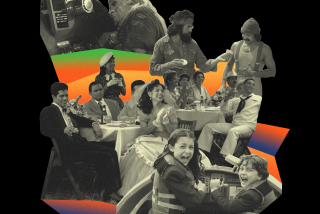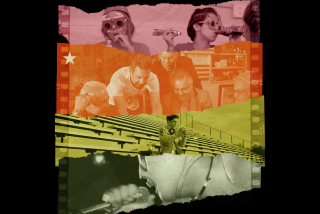Cheech, a giving person
- Share via
When we think of art patrons, prestigious names normally come to mind. Medici, Getty, Rockefeller.
But Cheech?
That’s a name we associate more with lowbrow humor than fine art. Yet Cheech Marin, half of the ‘70s comedy duo Cheech and Chong, arguably has emerged as the nation’s leading advocate for Chicano art.
For a time, Marin, 60, was sounding like the Rodney Dangerfield of the art world, always complaining that he can’t get no respect from the arts establishment. Nobody’s laughing nowadays. For the past five years, the actor has taken his personal art collection on tour in an exhibition titled “Chicano Visions: American Painters on the Verge,” which appeared at major galleries, drew strong attendance and garnered generally positive reviews.
The actor last week returned to Los Angeles, his hometown, to announce the donation of 50 sets of high-quality digital prints from his traveling collection to museums and universities across the country. Recipients include several museums that have already hosted the exhibition, among them the Smithsonian Institution in Washington, D.C., the De Young Museum in San Francisco and the San Antonio Museum of Art, where it debuted in 2001.
Locally, print portfolios will also go to LACMA, where a version of “Chicano Visions” is set for early next year, and to at least two colleges, UCLA and Cal State Northridge, the latter of which is the actor’s alma mater.
The artfully boxed sets include fine-art reproductions, known as giclees, of 26 works, accompanied by woodcut portraits and profiles of each artist. Represented are some of the most respected names in the field, many from Los Angeles, such as John Valadez, Patssi Valdez and Carlos Almaraz.
A few of those artists joined the comedian for the announcement at the Pico House Gallery near Olvera Street, where the prints had been on display. Marin donned special archival gloves and gingerly held up some of the prints for photographers, including one recent painting by Chaz Bojorquez called “Chino Latino,” an abstract swirl of images and symbols.
When the artist gently noted that they were holding the print the wrong way, Marin cracked a joke and saved face.
“That’s what’s great about Chicano art -- it doesn’t matter if it’s upside down,” he said, turning the print around.
In an interview, the comedian was much more serious about the subject. He repeated now familiar lines he’s been using as his exhibition traveled from city to city: Chicano art is American art made by world-class artists. It has earned its place in museums and universities as a legitimate school of art.
As he spoke, he was sitting in front of a dynamic painting titled “Kill the Pachuco Bastard!” by Vincent Valdez, the youngest artist in the collection. It depicts a violent fight during the Zoot Suit riots of the 1940s, when U.S. servicemen attacked, stripped and beat young Mexican American men in Los Angeles with the complicity of the police and the press. It was a seminal event in the Chicano civil rights struggle and fitting backdrop as Cheech Marin recounted his own battles, on two fronts. He has had to confront community activists who wanted to dictate what qualifies as Chicano art and stand up to leaders in the art world who wanted to dictate what qualifies as art, period.
His experience proves that being an art patron takes conviction, fortitude, wealth, persistence, a thick skin and a vision of the future.
Marin may have a funny name, but it’s sobering to think where Chicano art would be without him. A lot less visible, for sure. But it’s bound to become even more visible, he argues, as the growing Latino immigrant population moves into the middle class, elevating art along with them.
“The future Eli Broads are coming out of this gene pool,” he said, referring to the L.A. real estate tycoon and art collector. “There’s no way to stop it. It’s like standing in front of a lava flow.”
Assads to play LACMA event
While Cheech Marin seeks exposure for contemporary Chicano art, LACMA is using music this week to turn the spotlight on its permanent collection of Latin American art. Guitarists Sergio and Odair Assad, the Brazilian duo popular in world music circles, are set to perform Tuesday at the museum’s Bing Theater, playing works by Piazzolla, Gismonti and Rodrigo, as well as Sergio Assad’s own “Farewell,” in its L.A. premiere.
The semi-classical music serves to underscore the cultural gulf separating prized international paintings and the barrio roots of Chicano art, which goes better with a little Ozomatli or Quetzal. Still, variety is the spice of life and the Assad brothers are a fine choice for this refined venue.
On Cinco de Mayo, the museum gets a little more rowdy with the outdoor performance of L.A. salsa veterans Son Mayor. The band kicks off LACMA’s Latin Sounds series of free concerts, continuing 5 to 7 p.m. every Saturday through September, at the amphitheater in the park behind the museum.
Mark your calendar now for Aug. 8 when the series features the AlexCubaBand, one of the most intriguing yet little known salsa/son groups in the world. The leader is Alexis Puentes, a Cuban immigrant who moved to Canada where he formed an excellent duo, the Puentes Brothers, with his twin, Adonis. The pair released a tasty album, 2001’s “Morumba Cubana,” available at Amazon.com. Alexis released his first solo album, “Agua de Pozo,” in February with a fresh, contemporary twist. (www.alexcuba.com).
In his case, go for the music. The art will always be there.
For information on all LACMA shows, call the box office at (323) 857-6010 or go to www.lacma.org/.
Burns hires Galan for WWII doc
Filmmaker Hector Galan has a plea for critics who remain skeptical about efforts to add Latino stories to the upcoming PBS documentary about World War II: Just give him a chance.
Galan was selected this week to help famed documentarian Ken Burns revise the 14-hour series, which had been vigorously criticized for excluding Latinos. The announcement didn’t appease some critics, who feared that the new Latino material would be tacked on the series as an afterthought.
Latinos aren’t a footnote to history, argued Sen. Robert Menendez (D-N.J.), a member of the Congressional Hispanic Caucus, which was urged by activists to look into federal funding of PBS in light of their grievances.
Hold your fire, says the Austin-based Galan, a WWII buff who has made many films about Latino politics and culture. He promises that the new Latino stories will be “incorporated seamlessly into the series so it doesn’t feel it was added on or tacked on or anything like that.”
Galan says he has seen the series and notes that Latinos appear in the footage but not as interview subjects. (If the film had aired with Latinos only in the background, I’m sure it would have exacerbated critics’ claims that Latinos were seen only as faceless “cannon fodder” in the war.)
“I don’t blame them for being upset,” Galan told me after his selection. “I was upset too. But you have to give us a chance. I would just say wait and see the series.”
*
Gurza covers Latino music, arts and culture. E-mail [email protected] with comments, events and ideas for this weekly feature.
More to Read
The biggest entertainment stories
Get our big stories about Hollywood, film, television, music, arts, culture and more right in your inbox as soon as they publish.
You may occasionally receive promotional content from the Los Angeles Times.










